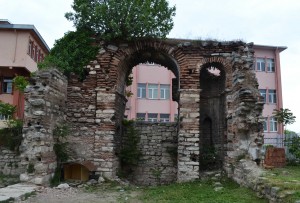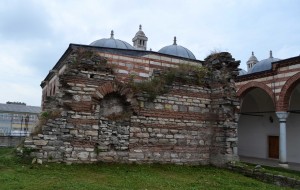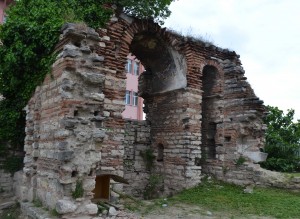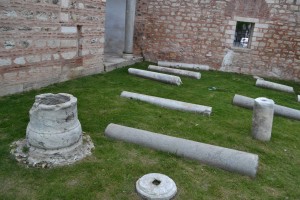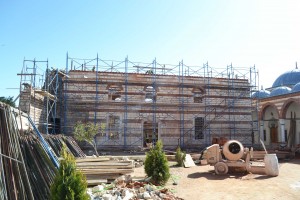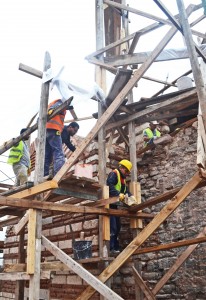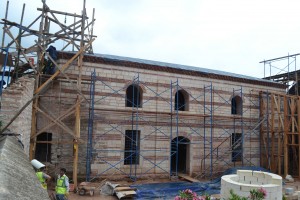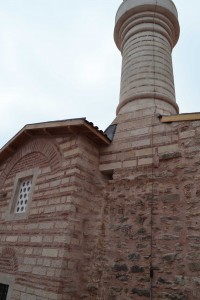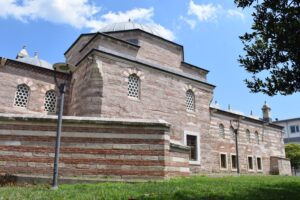There are a few bits of Byzantine wreckage here (41.004893,28.936502). It is in the south-west corner of the Cerrahpaşa hospital complex. The Medrese, a work of the great Sinan, has been reconstructed on the site but a wall with two remaining apses gives us a good impression of what one side of the church was like. According to Mamboury, some good frescoes were still visible in the early 1950s. Now there is a tiny bit of plaster in the central apse.
In May 2014, it was not open to the public. I went in anyway and was shouted at by a man who said he had seen me in there with a CCTV camera. Then followed a discussion in which he became angry. I asked him why he was getting cross. He laughed and said he wasn’t. We shook hands and parted friends.
This seems to be a Palaiologan building with the characteristic bands of alternating dark and light brick as seen in the Fethiye and Kariye mosques. As such it was presumably built in the late 13th or early 14th century. Raymond Janin suggested in 1953 that İsakapı Mescidi was originally the Monastery of Iasites. More recently, Papazotos has provided some evidence that this may be a church from the Monastery of the Patriach Athanasios. This would mean that it was built some time between 1282 and 1289.
In the 1550s, the church underwent its inevitable conversion into a small mosque. Mimar Siman built a tasteful medrese complex around it. This has just been restored by the ever-busy Fatih Belediyesi. The church may originally have had a dome but by the time Paspates [5] carried out his 1877 survey of Byzantine churches in Constantinople, the mescid had a plain tiled roof. Professor Thomas Mathews [6]‘s excellent site has some pictures from 1935 (click on the numbers). Nicholas Artamonoff [7] photographed the site in 1936. The deterioration in the condition of the building is largely due to the effects of the 1894 earthquake, the end of the useful life of the building.
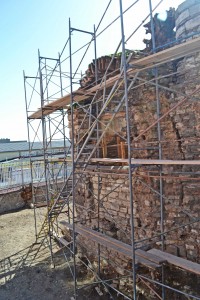 [9]
[9]It will take a light touch to preserve this ravaged brickwork as part of a newly contructed building.
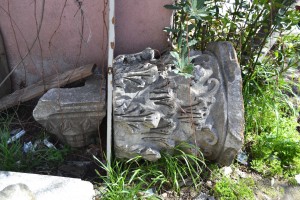 [10]
[10]Byzantine capitals nestling behind the carpark attendant’s hut at Cerrahpaşa Hospital. These have now been moved elsewhere.
Until now. I was nosing about the area in March 2015 and came across feverish building activity. The architect’s site about the restoration [11] purveys the rather unconvincing notion that the mescid was built by Sinan. Despite this, the work seems to be doing a reasonable job of preserving what remains and supporting it with masonry that reflects the spirit of Palaiologan brickwork. It appears that it may become a library of the history of medicine for the University of Istanbul.
Work was well advanced in June 2015. The old sections of the wall were fully enclosed by modern brickwork and the ticklish task of joining the parts together was nearing completion.
As of January 2016, the building is almost finished. The floors are being done and the men on duty said that it would open as a mosque in (expressive shrugs of shoulders) a few months. A minaret has been built and the Byzantine section of wall is integrated into the whole structure.
I wasn’t permitted to photograph inside but the remnants of fresco seem to have been cleaned with a reasonable degree of sensitivity. This is certainly no longer a Byzantine structure but if nothing had been done, it would have been a pile of stones in twenty years. So thanks, Fatih Belediyesi.
As of July 2019, building work in the surrounding hospital restricted access to the site. It looks as if the mescid and medrese are not yet in full use.
 [16]
[16]
